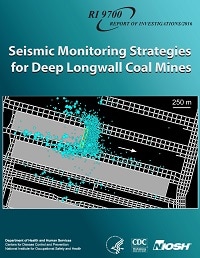Mining Publication: Seismic Monitoring Strategies for Deep Longwall Coal Mines
Original creation date: September 2016
Authors: PL Swanson, MS Boltz, DJ Chambers
NIOSHTIC2 Number: 20048758
Spokane, WA: U.S. Department of Health and Human Services, Centers for Disease Control and Prevention, National Institute for Occupational Safety and Health
This report presents five strategies for detecting and recording seismic activity associated with deep longwall coal mining:
- Single-station monitoring
- Augmentation of an existing regional seismic network
- Temporary network deployment
- Implementation of a mine-wide or district-wide network
- Installation of a dense microseismic network
These strategies take into consideration: (1) the variety of potential objectives for seismic monitoring, (2) the notable contrast of coal mining environments with conditions in hardrock mines, where these techniques were originally developed, (3) the enormous range in magnitude and physical size of seismic events, and (4) the significant variation in expense and complexity of the different approaches. The strategies range from simple and inexpensive methods that can be implemented on the surface by a mining engineer to complex and expensive endeavors requiring involvement by underground mine personnel and monitoring-system suppliers. This report provides example monitoring results from deep longwall coal mines, and describes the capabilities and limitations of each of the five suggested approaches.

NIOSHTIC2 Number: 20048758
Spokane, WA: U.S. Department of Health and Human Services, Centers for Disease Control and Prevention, National Institute for Occupational Safety and Health